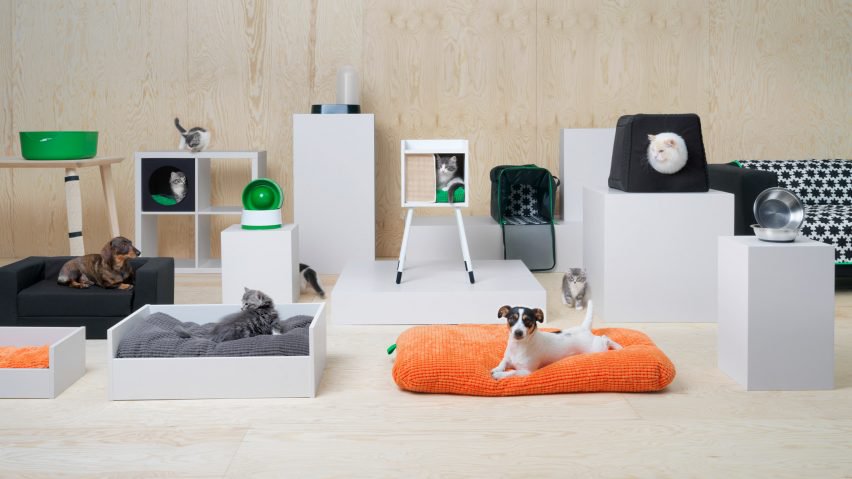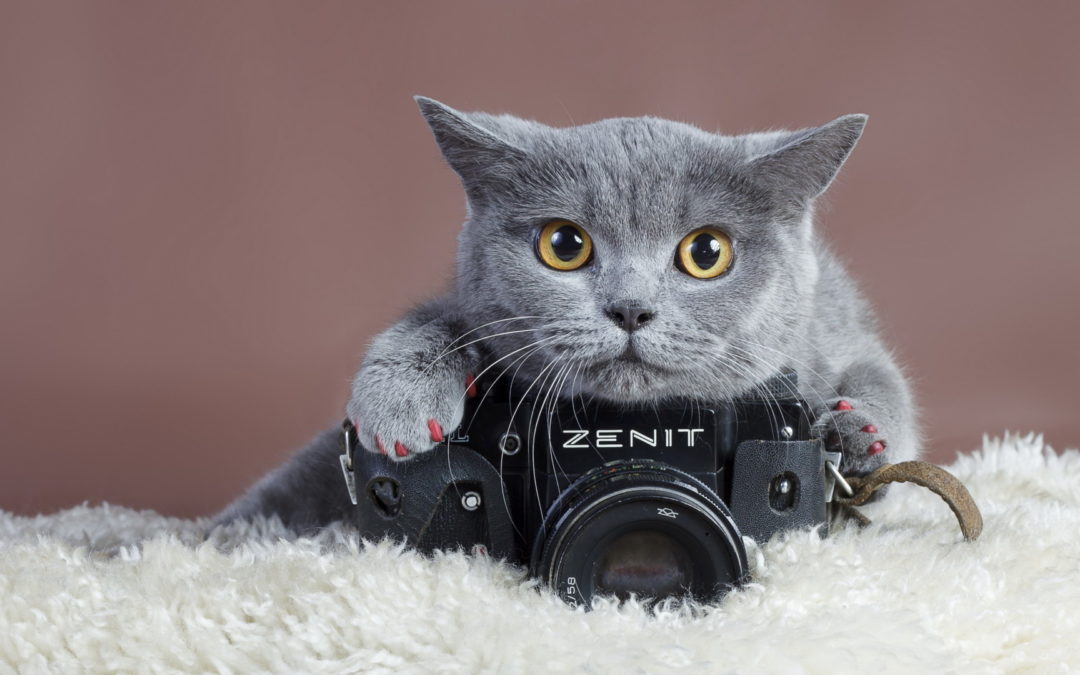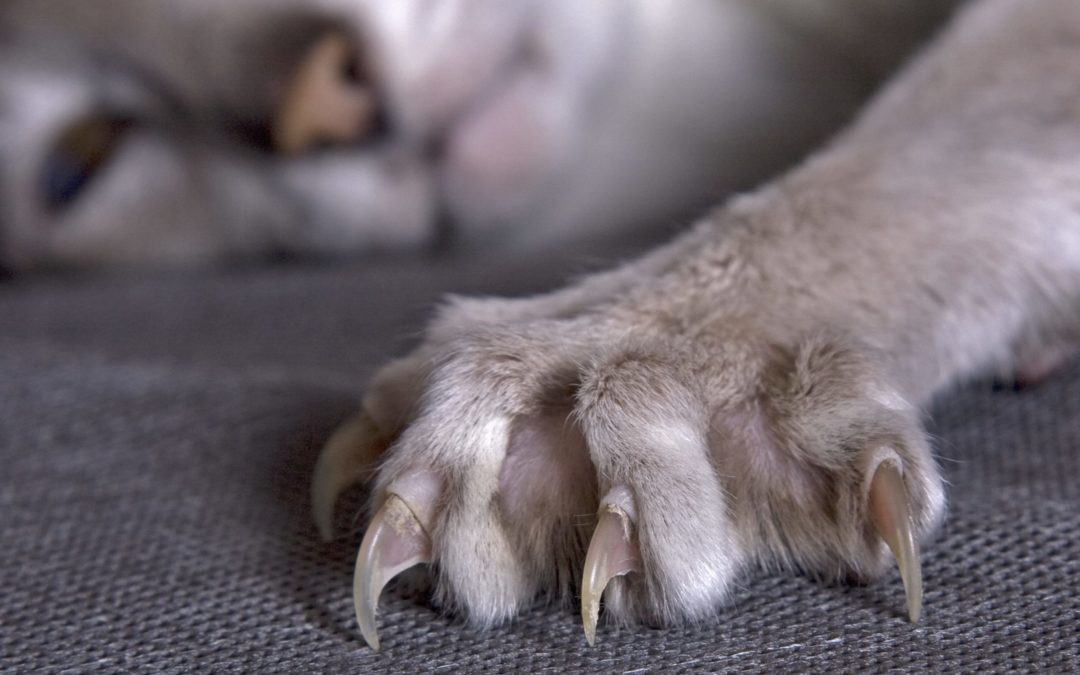
by Leah | Oct 24, 2017 | News & Current Events
We know you pet owners can’t wait to get your paws—er, hands—on them from reading the title alone and are struggling to contain yourselves. If you’re looking for reasons to justify not buying at least one or two pieces, this isn’t that kind of article. Though we’re not lobbying for you to go out and buy them right away, but we really should, you’ll find this collection more tantalizing than you imagined. That’s without us even trying to convince you. Did we mention there are accessories too? Insert knowing nod here.

Made to Integrate with Your Current Living
The good news is you don’t have to throw out any IKEA furniture you have. The bad news is, if you’re fighting off the urge to splurge on your pet, we can feel your resolve slowly slipping. This collection of special pet items called “Lurvig,” which is Swedish for hairy, are designed, not just to stand on their own, but are suited to go together with the rest of your home, particularly IKEA furniture.
Tired of seeing frays of wood on your table legs from your cat’s scratching? Now, you can compromise. The scratching mat was made to wrap around them perfectly. Also, the cat house can easily fit in your furniture to look almost like another compartment on a shelf. You can also have it raised with its own set of legs to give it some height, just the way your cat loves it. Then use it as another table or stand and place a decor on top like a potted plant, a lamp or books. It can also fit perfectly into its namesake shelf, Kallax. The play tunnel is compact and can easily fit under your dining table so it doesn’t get in the way…
You won’t need to compete with space on your couch anymore. Your pets can have their own. Yep, you read that right. It’s stylish and minimalist, too. If you feel it’s spoiling them a bit too much, just go straight to the pet bed. It’s comfy and attractive enough to look great in any part of your home whether next to your couch or by your bed. One pet owner even bought it for their bunny and posted it on Instagram. Think about it, if their bunny looked adorable on it, imagine how your cat would look lounging there.
Accessories
IKEA pretty much got everything covered. They have leashes, beds, sofa covers, blankets, travel bags and a cat toy. Before you take that trip down to your IKEA store, you need to muster every ounce of self-control or put yourself in danger of going on a big shopping trip for your pet. Then there are the usual tempting furniture you can buy for yourself, too.
For pet parents living outside of Japan, US, Canada, Portugal, and France, you won’t have the same struggle as the collection is only available in the aforementioned countries. For now. In the meantime, here’s to a more pet-loving, pet-welcoming business community, the ingenuity of a few who started what looks to soon be a revolution and to the day when this collection is global.
Meow for now… Kristian
Image Source

by Leah | Oct 19, 2017 | Behaviour & Training
As cat lovers, nothing beats getting home after a long day of work with your kitty welcoming you back to your house with purrs and with tails held high. But that’s not the only thing a cat’s tail does. We see and enjoy the company of our kitties every single day, but have we asked ourselves if we really know every single corner, joint, or part of our kitty’s body? Let’s start getting to know our kitties more! And one part that most people are not that much aware of is the purrty tail of kitties. Keep reading and you’ll find that a cat’s tail is more than just an elegant, furry swerving part of a kitty.

First, let’s get a bit scientific. Before we get to know what it’s for, we have to know what it’s made of and how it is able to move. An average cat’s tail measures 11 inches long for males and 9.9 inches long for females. It has 19 to 23 bones called vertebrae. That’s about 10 percent of the total number of bones in a kitty’s body, wrapped by a group of muscles, tendons, and ligaments which explains that elusive and magnificent movement that cats do with their tails.
Now, let’s start with the different uses and facts of this magnificent tail. Here are five of the primary use and facts of a cat’s tail.
Counterweight
Sure we’ve heard that a cat’s tail is used primarily for balance. But how is it able to balance kitties? The answer, Counterweight! It provides a bit more weight at the back parts of your kitty making walking along narrow areas such as fences or the backrest of your chair very easy for them. Because of this counterweight, felines are also able to dash or run fast and quickly make a sharp turn when chasing down a favorite toy or perhaps, dinner.
Tail Talk
Most of the communication that is being used by kitties depends on a lot of body language. The tail plays a major role in that, especially when communicating with a human. If you know “tail talk”, then you know how your kitty feels right away. If not, here are a few things that may get you started.
A happy kitty walks with the tail held high, for some cases, when your kitty is really happy, apart from the tail being held high, a quiver will also be formed at the tip of the tail.
When stalking prey or toy, the tail is being held low, not only to conceal the kitty’s presence but also to maintain balance while slowly making silent footsteps towards the prey…or toy. There are also instances that the tail may be twitching a little bit at the tip as a form of controlling kitty’s excitement.
An annoyed kitty will have the tip of the tail twitching. If the tail is moving back and forth like a whip, step away from that very instant, because what comes next is a sharp claw that’s ready to scratch.
Permanent Damage
The spinal cord of a kitty, which controls all movement and function of the body, does not extend all the way to the tip of the tail. But at the very tip of that spinal cord which is also where the tail starts, is what primarily controls the lower functions of the cat, namely, the tail, hind legs, bladder anus, and large intestine. Pulling a cat’s tail may cause partial paralysis, incontinence, or chronic pain. The same happens if extensive damage is done to the tail as this may cause serious nerve damage.
Tailless Kitties
Cats can live without tails. They are very adaptable creatures and even if the tail is being surgically removed due to health reasons, they can easily compensate for the difference and change.
Tailless Breeds
Proof that cats don’t always need their tails is that there are certain breeds that are born without tails. The Manx, for example, is famous for the unique tailless look.
With tail or no tail, what matters most is how we look after our kitties and how we get to know them. Your feline companion is a companion for life. Get to know them little by little and taking care of them will follow smoothly.
Meow for now… Kristian
Image Source

by Leah | Oct 17, 2017 | Humor & Fun
As cat lovers, we tend to have feline instincts ourselves as well. Feline instincts to take photos of our feline friends and show the world just how cute and adorable our kitties are. I bet you’ve tried taking a picture of your kitty once or twice and noticed that it can be quite difficult, right? Cats have nothing to do with photo shoots and cameras. They just want to live their lives as they please. But fear not, here are a few things that you can bear in mind for you to be able to get that prized shot.

猫的眼神
Patience
That is the number one virtue that you need to have when you think about taking pictures of your kitty. Patience! Sure, cats may just lounge around your house the entire day, but once the camera or phone is spotted, your feline friend may suddenly seem to be camera shy. Changing positions, covering the face with their paws, or even just walking away. But with patience, you will find that it truly is worth the wait.
Feline Director
Your kitty is the director of this photoshoot. Don’t choose the spots or scenery; let your feline friend do it. It’s a photo of her, so let her choose where she wants the picture taken. Snap a stealthy photo while kitty is comfortable, that way, by the time she notices the camera, you would have had an adorable picture of her already.
Meet Halfway
Bear in mind that great photographers would go through different positions to get that perfect snap shot. The same applies to this scenario. Drop on the floor and take a picture at your kitty’s eye level. Not only will this attract your kitty, but also, looking down on your kitty might distort the photo that you are trying to capture. Unless if that is your original intention.
Keep an Eye on the Background
Background changes everything. Sure, your kitty may be striking an awesome pose, but what about the dirty laundry behind that pose? Not all background stuff can be cropped or edited. Check online and you’ll see what I mean. An awesome feline doing an awesome pose deserves an awesome background.
Bribery is a Good Policy
Bribery can come in different forms for a cat. From treats to catnip, use anything within your arsenal that can catch the attention of your kitty and make her go the direction that you want her to. Just make sure that nothing can harm your kitty while doing this.
Two Heads are Better than One
It’s no easy task to dive into cat photography. So call a friend and two of you can work on it. One can distract kitty, while the other takes snaps of photos.
Flash Photography
The use of flash photography can go two different ways. And none of them are easy. First, it may startle your cat which would leave a scar in your feline companion’s memory to avoid cameras. The other would be triggering your cat’s curiosity. When your cute ball of fur sees the flash, they can be attracted to it and once they get curious, it is really hard to stop them from investigating. This may get you good close up pics, but it would make lounging or portrait photos a tad more difficult. So avoid flash photography.
One of a Kind
Every cat is one of a kind. All are unique and have different preferences. For some cats, treats may work and get them to do cute poses, but it may not work for others. So don’t hesitate to experiment. Get to know your cat more while doing a photo shoot. This will draw both of you closer.
You know your cute furball better than anyone else. Doing a photoshoot will let the world know the beauty of the relationship you have with your kitty. Don’t be afraid to look weird. Cats do weird things to grab our attention, why don’t we do the same to grab theirs?
Meow for now… Kristian
Image Source

by Leah | Oct 12, 2017 | Humor & Fun
Ever wonder how cats can grow so big? Sometimes, it’s hard to tell if they’re already in their prime or at their tenure years.

Like humans, kitties also have different stages of life. Every stage has a distinct appearance, attitude and how we should approach them.
l. The Kitten (0 – 6 Months)
Appearance
It mustn’t be that hard to spot a kitten. They’re tiny, shaky and can barely walk. Everything about this stage is small – the ears, paws, and tail… so small that it makes you want to just carry it with you always to assure its safety.
Attitude
This stage is all about learning. Kittens are drop dead curious about everything in their surroundings. They are always curious, don’t get me wrong, but their energy at this young and wild age is the often cause why the cushion is destroyed, curtains are torn, and things that aren’t supposedly touched are already scrambled.
Approach
The best approach during this age is to be gentle and patient as you can be. Have him/her the necessary first-time vaccines to prevent unwanted diseases. This is the stage where they will be wild and energetic. You may have to kitten-proof your home by blocking dangerous places he/she can climb, fall or be trap into. It’s better to prevent than cure, so they say.
ll. The Junior Cat (6 months – 2 years)
Appearance
As kitty grows he/she eventually losses that palm-sized cuteness and enter a new and awkward stage. Kitty will have growth spurts that would make him/her long and lanky before she puffs up. Well, it’s that or it’s undernutrition.
Attitude
By the time she reaches 18 months, she’s more likely to be calmer than before. Kitty will start to let go of that rambunctious behavior and learn to be an adult.
Approach
She will need less supervision, but you must keep them in touch with the vet for his/her vaccination. At this stage, it is wise to start the transition from kitten food to adult cat food. In some cases, cats at this stage inflate after being spayed or neutered. It is advisable to monitor kitty’s food intake to make sure he/she is not being overfed.
lll. The Prime Cat (3 – 6 years)
Appearance
This stage is the equivalent of man’s 20 to 30’s. Kitty at this stage is at his/her peak when it comes to physical fitness. Their bodies should be buff but not overweight. By this time, their coats are now sly and shiny.
Attitude
This is the time when kitty is at his/her full natural temperament. It is different from one cat to another. They have developed characteristics depending on where and how they were raised. Whatever traits your kitties have at this age will forever be carried on. With an established territory, kitty should be playful at this age.
Approach
Even though kitty is in his/her prime health, a regular trip down the vet is advised. At this stage, they should be fully trained. From time to time, you may need to remind them about the rules but not too much. If your kitties have an unmanaged behavior, consulting a professional is the way to go. Cats at this age can still be trained.
lV. The Mature Cat (7 – 10 years)
Appearance
Age doesn’t matter but at this stage, your kitty is in her 30’s to 40’s in the human world. Their appearance doesn’t have that much change apart from weight gain. This is the stage where we often see why fat rhymes with cats.
Attitude
Some cats at this stage retain their playfulness but others tend to slow down. The bigger they get, the lazier and slow they become.
Approach
At this stage, you may want your cat to be more physically involved for they are now prone to being overweight. You should also let them have regular check-ups because they are also prone to obesity-related problems such as diabetes, high-blood pressure, thyroid or cancer. Keep your kitty healthy. Exercise!
V. Senior and Geriatric Cat (11 years – up)
Appearance
In their 11 to 14 years, they are called seniors. 14 years up, they’re already considered geriatric cats. It is during this age that the physical appearance signs of aging are now evident. The shine in their coats are now slowly disappearing.
Attitude
Kitties at this stage are very prone to diseases and mobility issues. Some kitties slowdown that they tend to forget her litter training. They are most likely to spend their days like Garfield does – being lazy. And, that’s not because they are, it’s because they are already at their days of seniority.
Approach
Geriatric cats can be a challenge to take care of. You need to closely monitor for health problems and continue those check-ups. Keep him/her comfortable as possible. Put everything he/she need within an ease of reach. If they develop health problems, it is advisable to switch her food to cat food formula to meet all their nutritional needs.
Now, the changes of your cat will no longer come as a surprise for you. The two things you need to be able to live a happy life with your kitties are patience and love. With that, every stage they enter will be a journey for you to discover and enjoy.
Meow for now… Kristian
Image Source

by Leah | Oct 10, 2017 | Behaviour & Training
I’m sure that a lot of us find kitty paws really cute. Within that cute, furry paw, lies a sharp and tricky tool that our feline friends have. That’s right, that’s the cat’s claw. Being cat lovers, we all know about this, some of us hate it, while some of us are good with it. But one thing is for sure, just like every part of a kitty’s body, the claw plays important roles as well.

The Logan of the Animal Kingdom
Logan, as in, Wolverine in the famous comic book series, cartoon series, and movie series from Marvel. If you’re familiar with this guy, then you know of his mutant abilities especially his retractable adamantium claws. So what does this have to do with a cat’s claw? Just like Wolverine, cats can also conceal their claws. Although Wolverine’s may be retractable, for cats, it would be more appropriate to say that their claws are “protractable”. This is because the natural state of our feline cutie’s claws is hidden. It is attached to the final toe bone of their legs and is attached to an elastic ligament. When in a tight situation, be it frightened or excited, the muscles of kitty will pull the tendons back exposing the claws. So it’s not the claw itself that is moving just like Wolverine’s, rather, the muscles around it.
The Hidden Blade
That’s right! It acts like a hidden blade for cats. But just like any other blade, it needs to be sharpened from time to time. That is one of the main reasons why your kitty loves scratching. This is their form of sharpening their claws. Giving your beloved kitty a scratching post or a place to scratch will definitely be useful both for your kitty and also to save your furniture at home.
Aside from scratching and tearing things apart, there are many uses for the claw in kitty’s day to day life. Here are the primary uses for them;
Hunting
Cats are natural born hunters. Even if you play with your kitty, you will be able to notice these hunter tendencies. Point a laser on the ground and your kitty will surely pounce on it quickly as if a prey was just caught. Their claws are effective in hunting. They can keep it hidden while stalking on their prey to stay quiet and in a blink of an eye, a claw strikes down the prey. Imagine if the claws weren’t “protractable”, the claws would make contact on the floor or any surface where kitty would be standing, making noise, and alerting the prey.
Climbing
Being natural hunters, not all hunts take place on the ground. They can also hunt from tall trees and they lay in wait on tree branches. This makes our feline companions “pawesome” climbers. Their claws are great at digging into tree barks making it easy for kitties to climb on trees or furniture. If their claws weren’t “protractable”, it would then make it hard for cats to pounce on a prey from a tree as their claws would keep them attached to the tree’s bark thus making them unable to make the pounce swiftly.
Defense Mechanism
Just like any creature in the animal kingdom, cat’s have a defense mechanism too. Even if they are natural born hunters and being good at it, they are not the only predators and hunters. When your kitty is scared or being chased down by a threat, their claws are their first line of defense.
Now that we know the primary uses of a cat’s claws, what comes to mind next is the thought of declawing. It is not advisable to have a cat declawed. Not only is this very painful for your kitty, but it can also prove to be life-threatening for your feline companion as well. Every part of your kitty’s body has a purpose, so why even think about taking out one of them?
Meow for now… Kristian
Image Source











